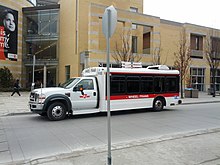Toronto Transit Commission bus system
[9] The TTC also experimented the use of trolley buses from 1922 to 1925, operating a line on Merton Avenue [sic] and Mount Pleasant Road.
By 1933, the TTC introduced the local bus and streetcar stop design, a white pole with a red band on the top and bottom.
When the Yonge–University subway was extended to York Mills station, the Yonge trolley bus line was closed and its buses were reassigned to serve Bay Street.
Poor welding led to corrosion problems, and the TTC retired 50 of the buses by 1999, while others were sold to OC Transpo in Ottawa.
The TTC sold Gray Coach Lines to the Scotland-based Stagecoach Group in 1990, while also introducing "community buses", providing minibus service in a few residential neighbourhoods.
[9] Supported by subsidies from senior governments, the TTC used CNG buses to replace its trolley bus fleet.
Because of safety concerns about CNG fuel tanks on the bus roof and low overhead clearances, these buses were banned from interior terminals.
The extension of Line 1 to Vaughan Metropolitan Centre opened in December 2017 caused the TTC to discontinue service on the 196, and since 2022, the 939B Finch Express is the only route that continues to use it.
[19] In December 2011, the TTC bus fleet became fully accessible with the retirement of the last of the old, non-accessible GM "New Look" buses, a model dating back to the 1950s.
Vaughan Metropolitan Centre, Highway 407, and Chester stations do not have any connections to regular daytime TTC bus routes.
[42][43] In 2020, as part of a municipal initiative dubbed RapidTO, the TTC started to set up priority bus lanes along several routes in Toronto.
[45] The lanes prevent road traffic from slowing bus service and disrupting the spacing between buses, which had resulted in gaps and bunching.
Priority lanes will not be implemented between Kennedy station and Brimley Road until construction for the Scarborough Subway Extension is completed.
For example, when the stop near two apartment buildings at Dale Avenue and Kingston Road was eliminated, riders had to walk an extra 250 metres (820 ft).
[49] A 2021 city study reported that routes passing through the Eglinton East RapidTO lanes had a 10-percent increase in on-time reliability and up to a 5-minute decrease in rush-hour trip time.
After the opening of the Toronto–York Spadina subway extension in 2017, the busway was shortened to run 1.8 kilometres (1.1 mi) between Finch West station and Dufferin Street; it no longer serves its namesake university.
Along with bus location, APC data is transmitted to a central computer in real-time and is used for service planning and transit control, as well as to deter fare evasion by some degree.
Using APC data, the TTC can monitor passenger load on buses and optimize bus assignments on routes that have a potential for crowding.
Each bus features three doors, LED interior and exterior lighting and automatic central air conditioning and heating.
[88][89][90] In late April 2017, the TTC temporarily withdrew the entire Nova articulated fleet from service because one of the buses experienced a "full throttle", that is, an unexpected acceleration.
Nova provided a software fix that required 20 minutes per bus to install allowing buses to go back into service.
[7] The Orion VII hybrid buses, like its diesel counterparts, have features such as air-conditioning, GPS for automatic stop announcements, a wheelchair ramp and the ability to kneel at the front door for easier boarding.
The TTC received one bus each from manufacturers: California-based Proterra, Winnipeg-based New Flyer (part of NFI Group) and Chinese-based BYD.
The buses are expected to travel approximately 200 kilometres (120 mi) on a single charge; however, when the bus heater activates in cold weather, the range is reduced by 30 to 50 percent.
[98] In late April 2023, the federal government and the city announced they would jointly provide $700 million to fund the electrification of the TTC's bus fleet.
[92] Some of the newer TTC buses are equipped with 12 pairs of USB-A ports throughout the bus for passengers to charge their mobile devices.
[100] All TTC buses, except Wheel-Trans vehicles, are equipped with folding bicycle racks installed on the front of the bus.
[101] In mid-2005, the TTC began a pilot project to test bicycle racks on six selected routes as a way to boost ridership and to be more environmentally friendly.
[102] In July 2007, the Commission authorized the addition of bike racks to the remainder of the TTC bus fleet except for buses to be retired over the following three years.
Once the first slot is full, cyclists may bring their bikes inside the articulated bus during off-peak hours at the driver's discretion.








